
Rhinos!
In this Gallery (includes every species I have seen in the wild):
White Rhino
Black Rhino
Indian Rhino
Javan Rhino
Southern White Rhinoceros or Southern White Rhino (Ceratotherium simum simum)
The Southern White Rhinoceros or southern white rhino (Ceratotherium simum simum) is one of the two subspecies of the white rhinoceros (the other being the much rarer northern white rhinoceros). It is the most common and widespread subspecies of rhinoceros.
A document published by CITES in 2021, found the estimated total population of Southern White Rhino in 2021 to be 15,940 individuals, a decline of 24% since the previous census published in 2015. South Africa remains a stronghold for this subspecies, conserving an estimated 12,968 individuals as of 2021, down 20.22% since the previous census.
The southern white rhinoceros is the nominate subspecies; it was given the scientific name Ceratotherium simum simum by the English explorer William John Burchell in the 1810s. The subspecies is also known as Burchell's rhinoceros (Ceratotherium simum burchellii) after Burchell and Oswell's rhinoceros (Ceratotherium simum oswellii) after William Cotton Oswell, respectively. However, these are considered synonyms of its original scientific name.
Ceratotherium simum kiaboaba (or Rhinoceros kiaboaba), also known as straight-horned rhinoceros, was proposed as a different subspecies (or species) found near Lake Ngami and north of the Kalahari desert. However, it is now considered part of the southern white rhinoceros.
Following the phylogenetic species concept, research in 2010 suggested the southern and northern white rhinoceros may be different species, rather than subspecies, in which case the correct scientific name for the northern subspecies is Ceratotherium cottoni and the southern subspecies should be known as simply Ceratotherium simum. Distinct morphological and genetic differences suggest the two proposed species have been separated for at least a million years.
The southern white rhinoceros is one of largest and heaviest land animals in the world. It has an immense body and large head, a short neck and broad chest. Females weigh around 1,700 kg (3,750 lb) and males around 2,300 kg (5,070 lb). The head-and-body length is 3.4–4 m (11.2–13.1 ft) and a shoulder height of 160–186 cm (5.25–6.10 ft). It has two horns on its snout. The front horn is larger than the other horn and averages 60 cm (24 in) in length and can reach 150 cm (59 in). Females usually have longer but thinner horns than the males, who have larger but shorter ones. The southern white rhinoceros also has a prominent muscular hump that supports its large head. The colour of this animal can range from yellowish brown to slate grey. Most of its body hair is found on the ear fringes and tail bristles, with the rest distributed sparsely over the rest of the body. The southern white rhino has a distinctive flat, broad mouth that is used for grazing.Southern white rhinos are strictly herbivores (graminivores) that feed on short grasses.
Little is known about Southern White Rhinoceros mating habits,but females reproduce every 2-3 years.They give birth to a single calf after the gestation period that lasts around 16 months. Newborn calves weigh about 45 kg (100 pounds) at birth. Young usually become independent in 2-3 years. .
Southern White in Imfolozi South Africa
The southern white rhino lives in the grasslands and savannahs of southern Africa, ranging from South Africa to Zambia. About 98.5% of southern white rhino live in just five countries: South Africa, Namibia, Zimbabwe, Kenya and Uganda.
The southern white rhino was nearly extinct in the early 20th century, with less than 20 individuals in a single South African reserve. The small population of white rhinoceros slowly recovered over the years, growing to 840 individuals in the 1960s and to 1,000 in the 1980s. White rhino trophy hunting was legalized and regulated in 1968, and after initial miscalculations is now generally seen to have assisted in the species' recovery by providing incentives for landowners to boost rhino populations. In 2001, it was estimated that there were 11,670 white rhinos in the wild of southern Africa with a further 777 individuals in captivity worldwide, making it the most common rhinoceros in the world. By the end of 2007, wild-living southern white rhinos had increased to an estimated 17,480 animals. In 2015, there was an estimated population of 19,682–21,077 in the wild.
The southern white rhinoceros is listed as Near Threatened; it is mostly threatened by habitat loss, continuous poaching in recent years, and the high illegal demand for rhino horn for commercial purposes and use in traditional Chinese medicine.
Ceratotherium simum simum - images from various locations in South Africa


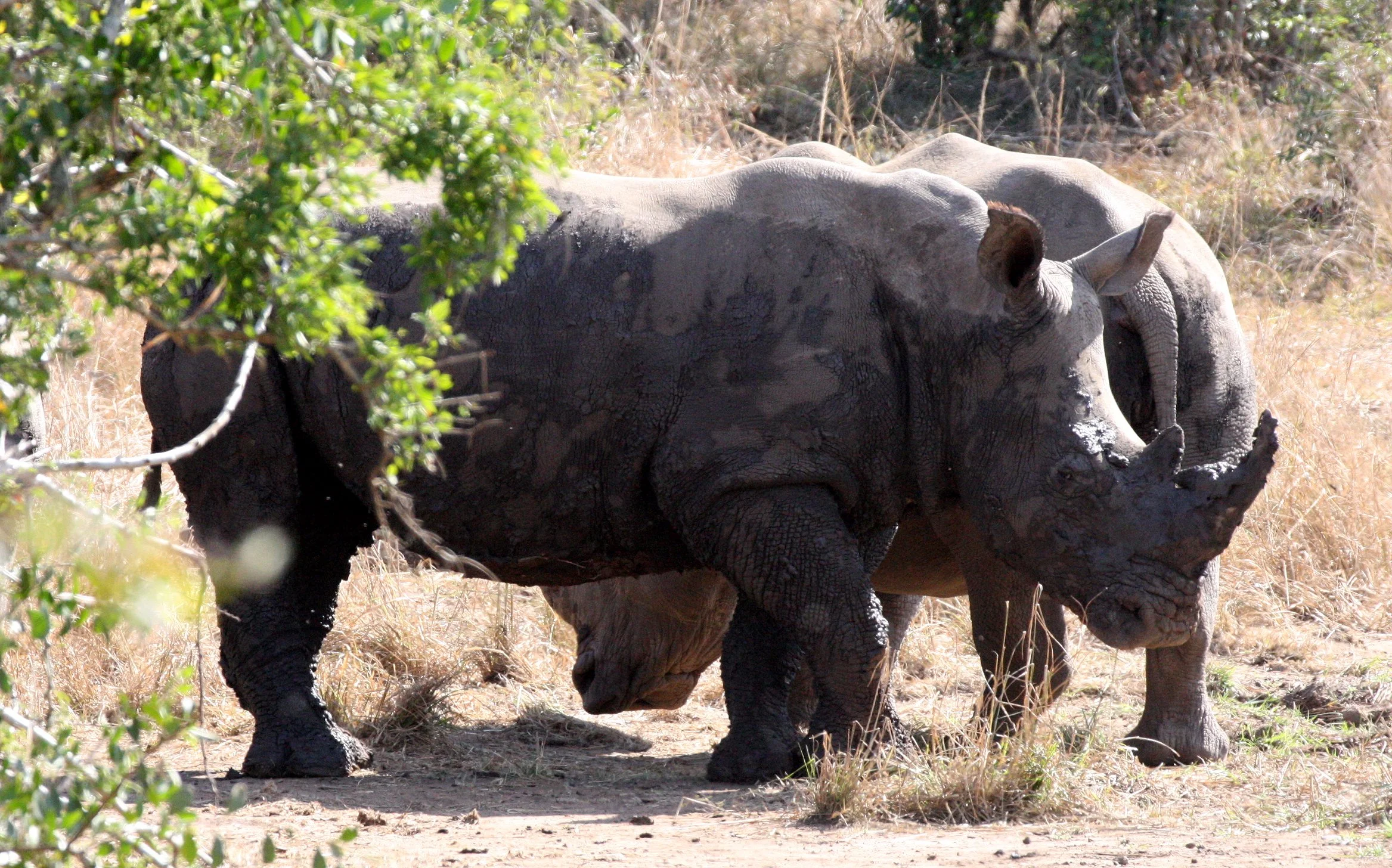






















































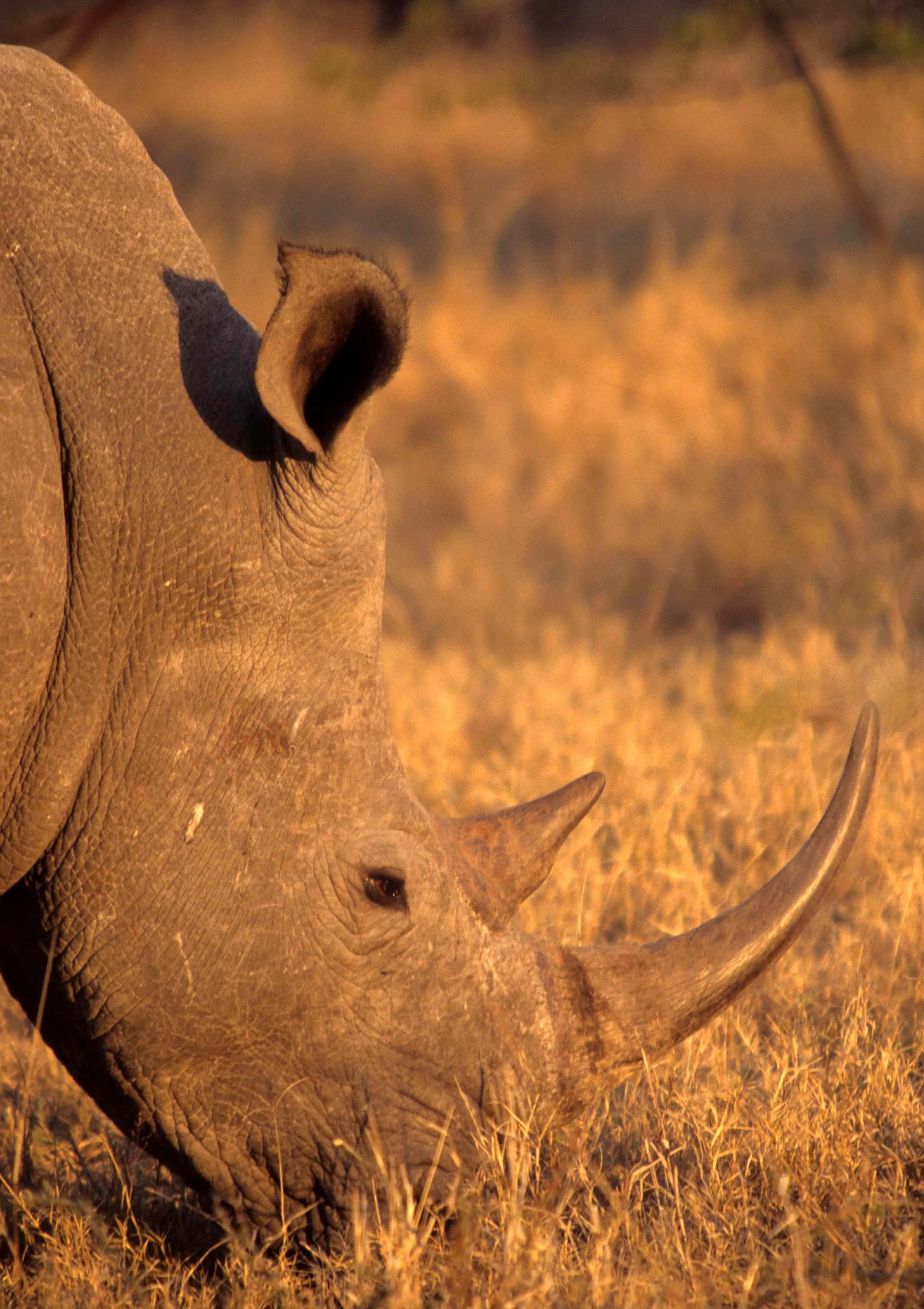
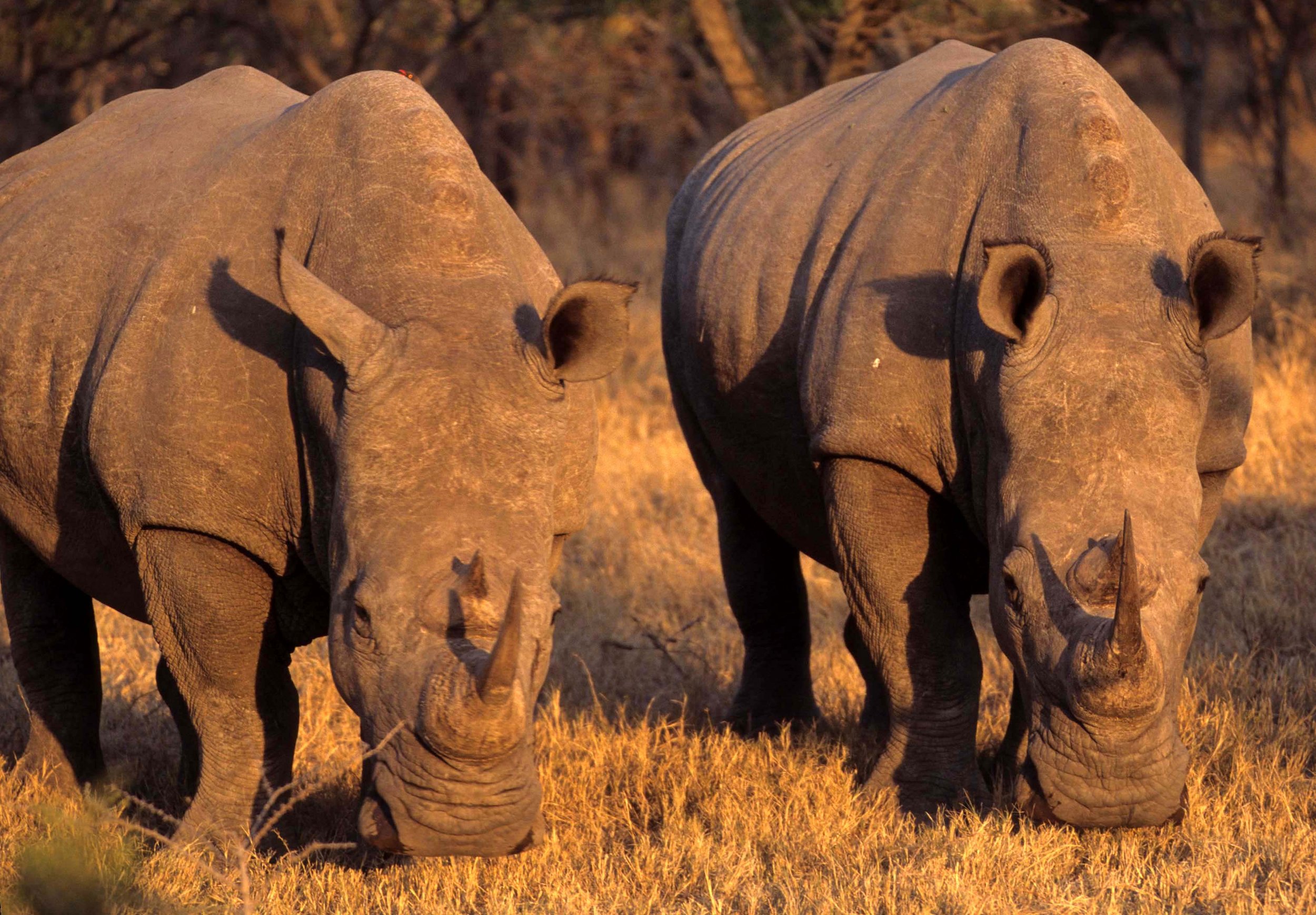
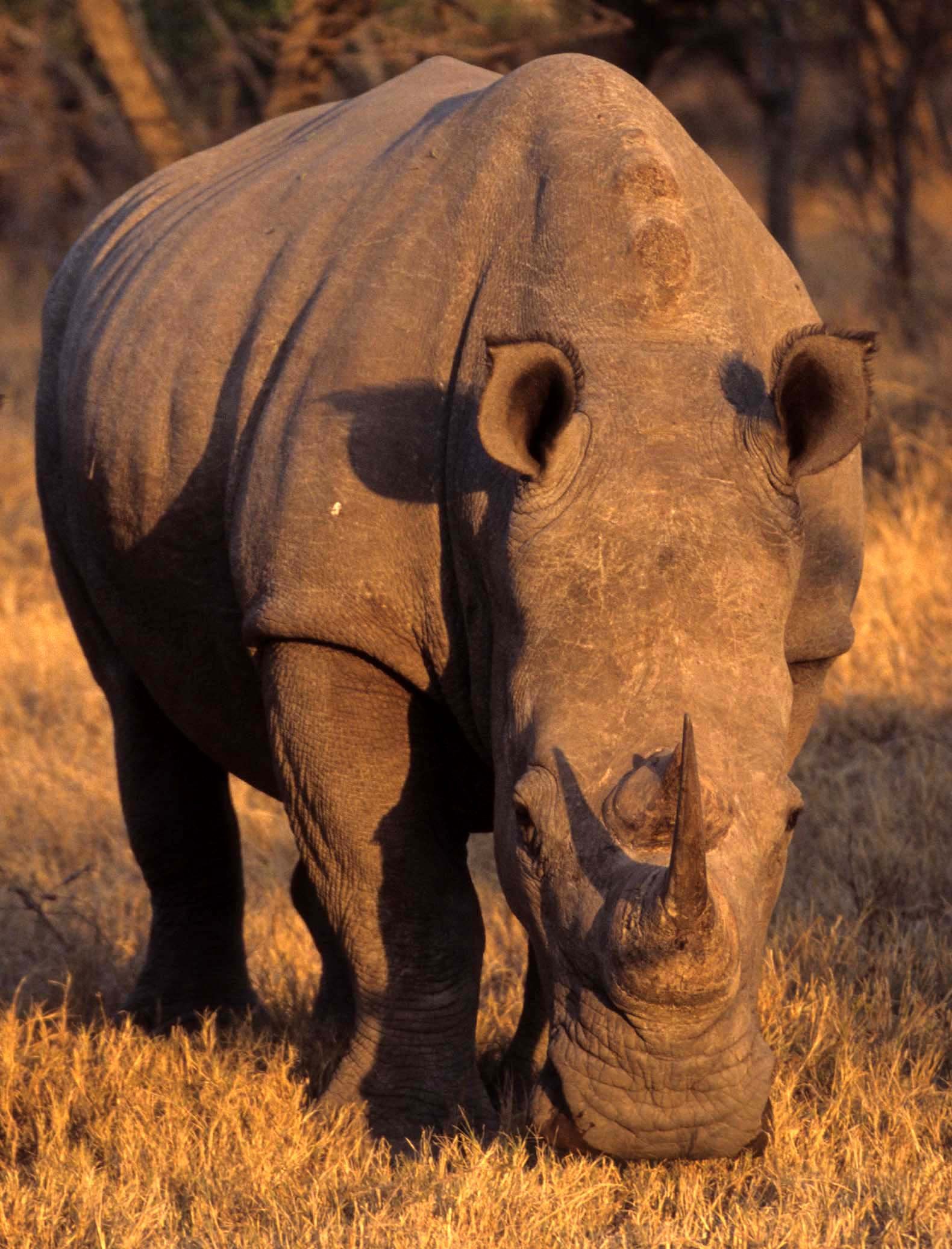
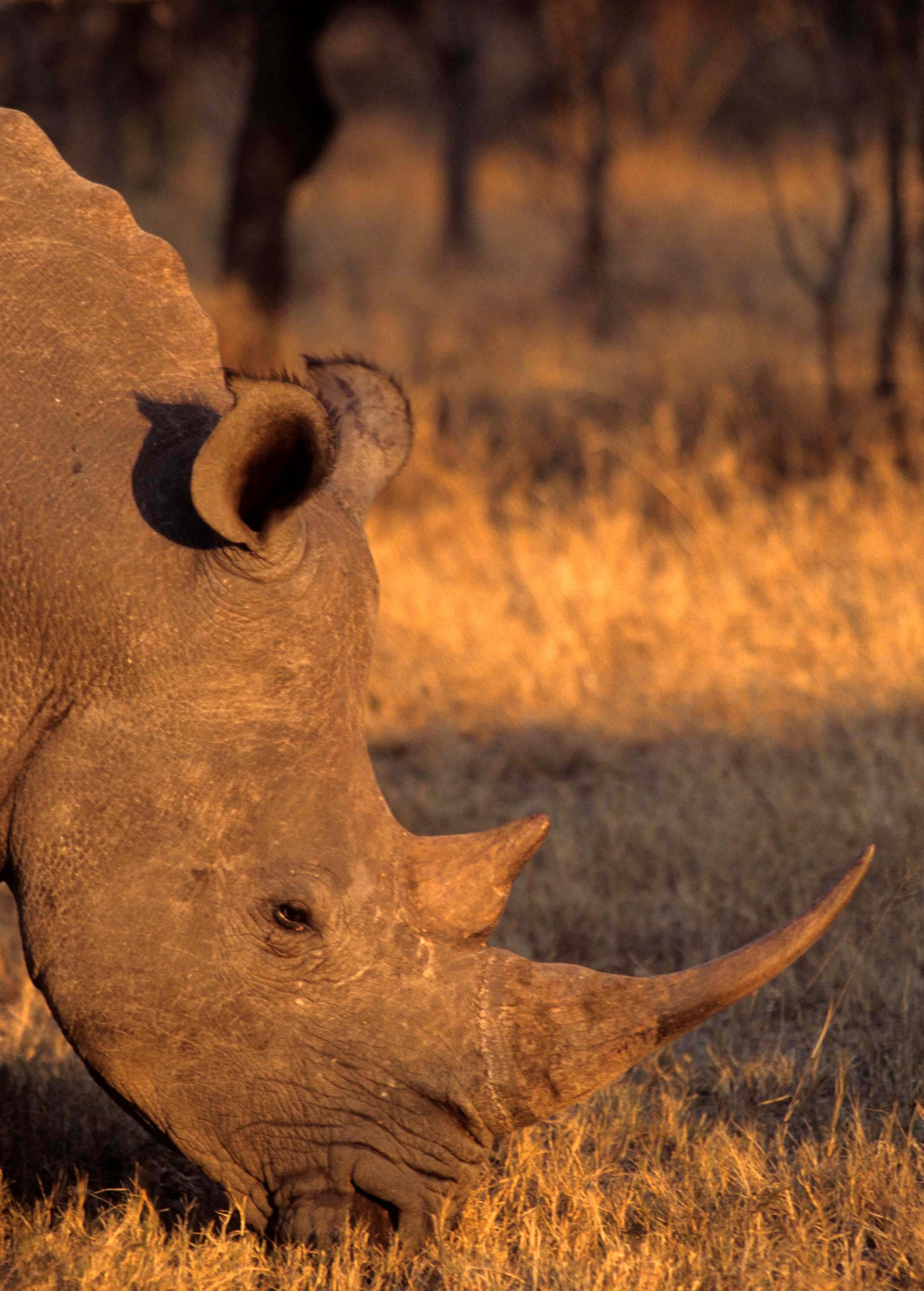
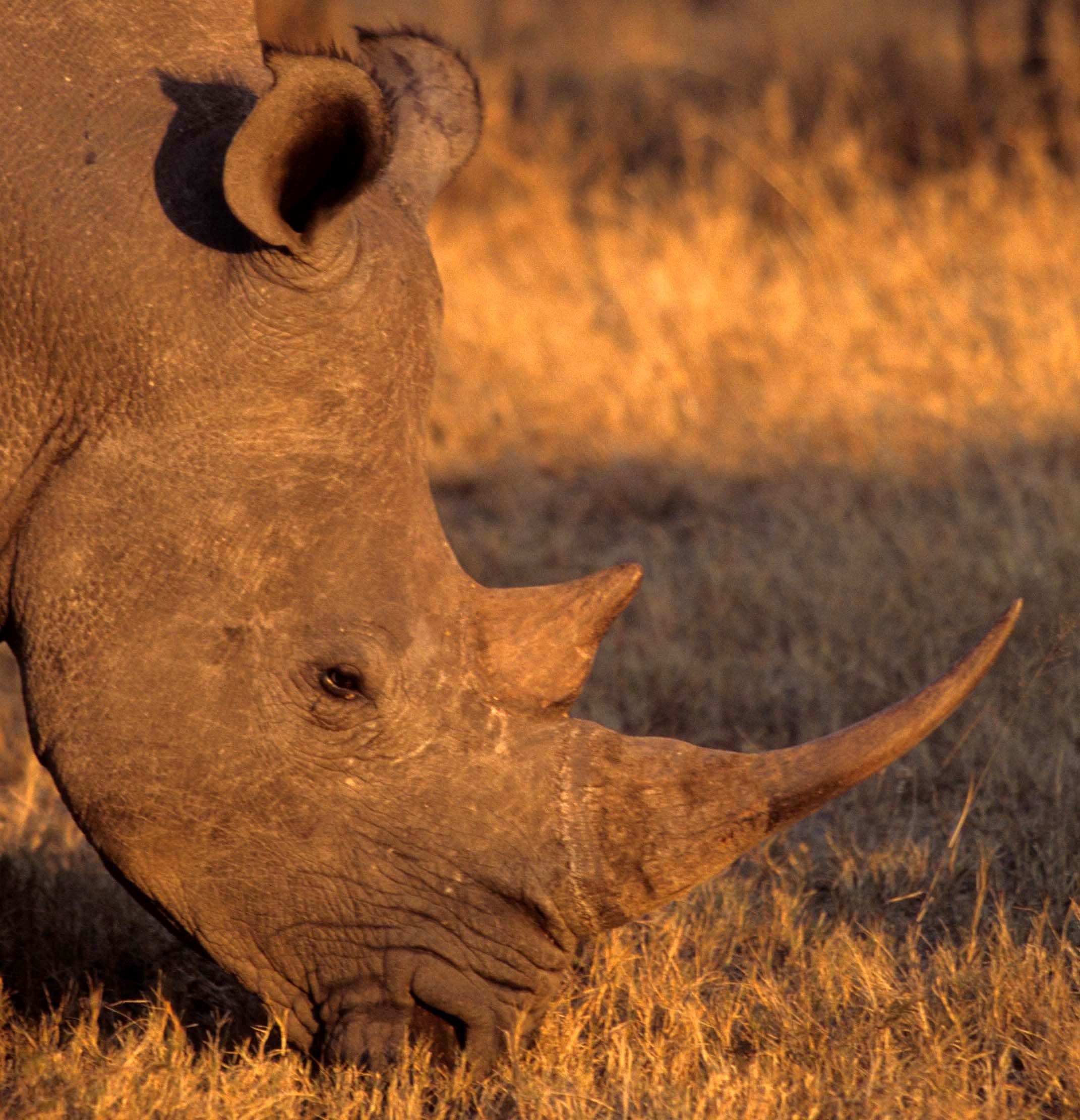
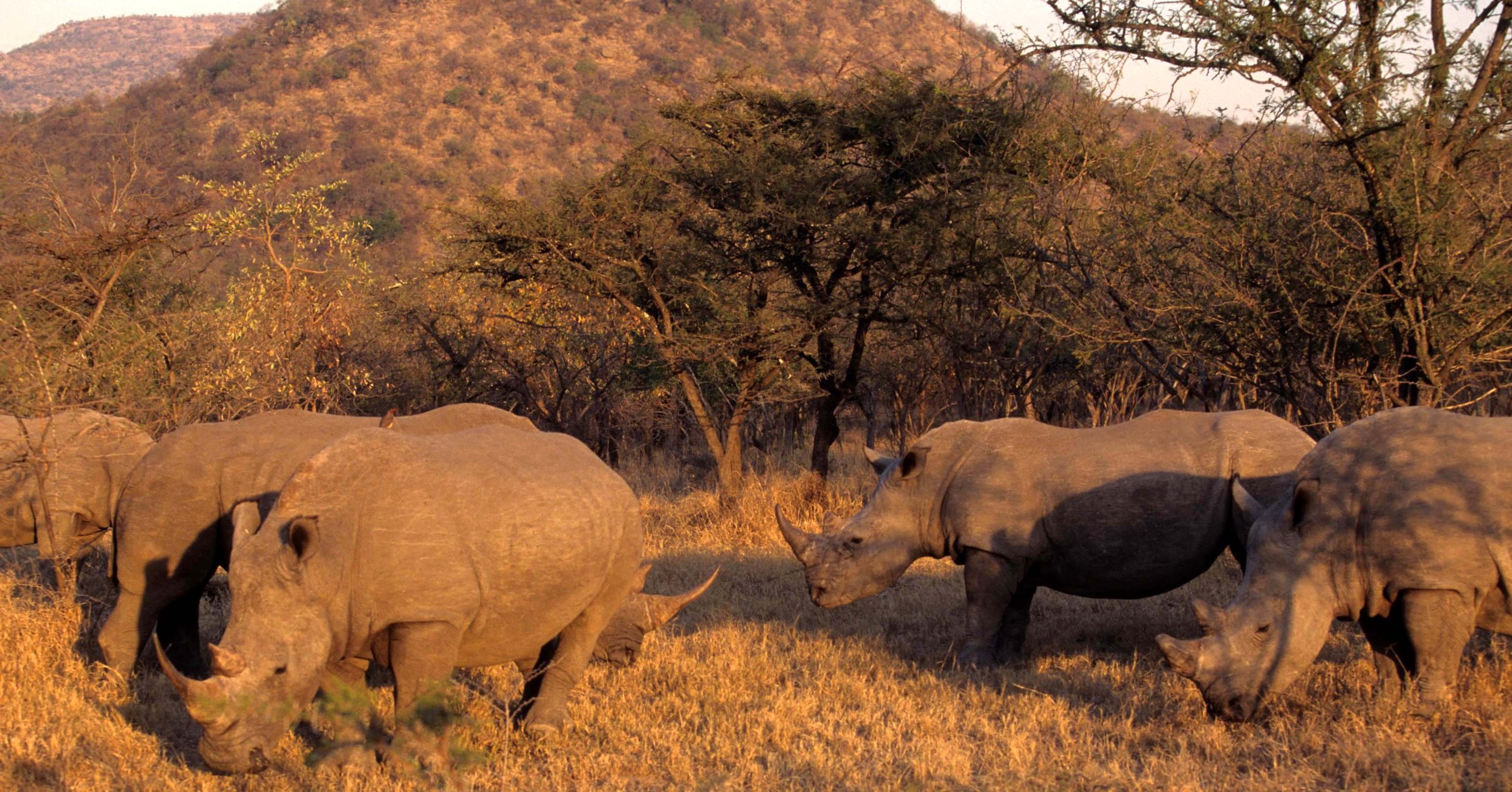
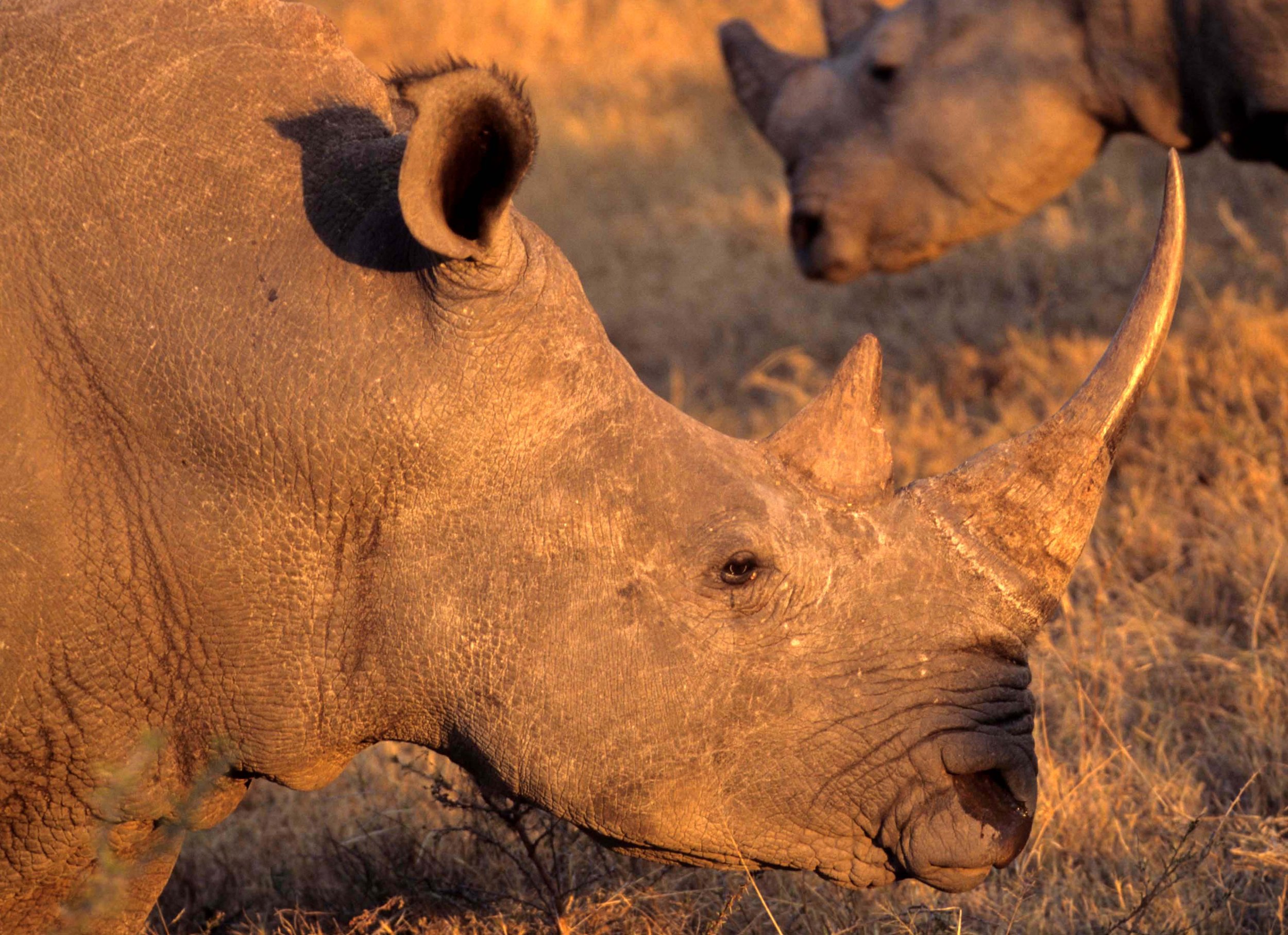
South-central Black Rhinoceros (Diceros bicornis minor)
The South-central Black Rhinoceros (Diceros bicornis minor), also known as the south-central hook-lipped rhinoceros or the lesser black rhino, is a subspecies of the black rhinoceros. In keeping with the rules of zoological nomenclature, the south-central black rhinoceros should be known as Diceros bicornis keitloa (Smith, 1836), a nomen novum. Although it is the most numerous of the black rhino subspecies, it is nevertheless designated as critically endangered on the IUCN’s red list. Like other black rhino subspecies, it has a prehensile lip and lives in savanna habitat.
The south-central black rhinoceros once ranged from western and southern Tanzania, through Malawi, Zambia, Zimbabwe, and Mozambique, all the way to northern and eastern South Africa. It is also thought to have inhabited the southern part of the Democratic Republic of the Congo, as well as northern Angola and eastern Botswana. Today, however, its population stronghold is in northeastern South Africa, and to a lesser extent in Zimbabwe, with even smaller numbers in Eswatini. At one time, the south-central black rhino had disappeared from Malawi, Botswana, and Zambia, but it has since been reintroduced into those countries. Whether there are any in Mozambique is uncertain, but at least one specimen has been seen there since 2008.
Over the last 50 years, the south-central black rhino population has declined by 90%. It was at 9,090 in 1980, but by 1995, due to a wave of illegal poaching for their horns, their numbers had decreased to 1,300. Their population then began to rebound somewhat. By 2001, it had increased to 1,651, and by 2010 it was about 2,200 (with 1,684 of these in South Africa, 431 in Zimbabwe, and a few specimens in other countries). At present the number is increasing overall, but decreasing regionally (in Zimbabwe). The main threat to the subspecies is illegal poaching, which has increased in recent years.
South-central Black Rhinoceros (Diceros bicornis minor) in the Karoo and Hwange Zimbabwe









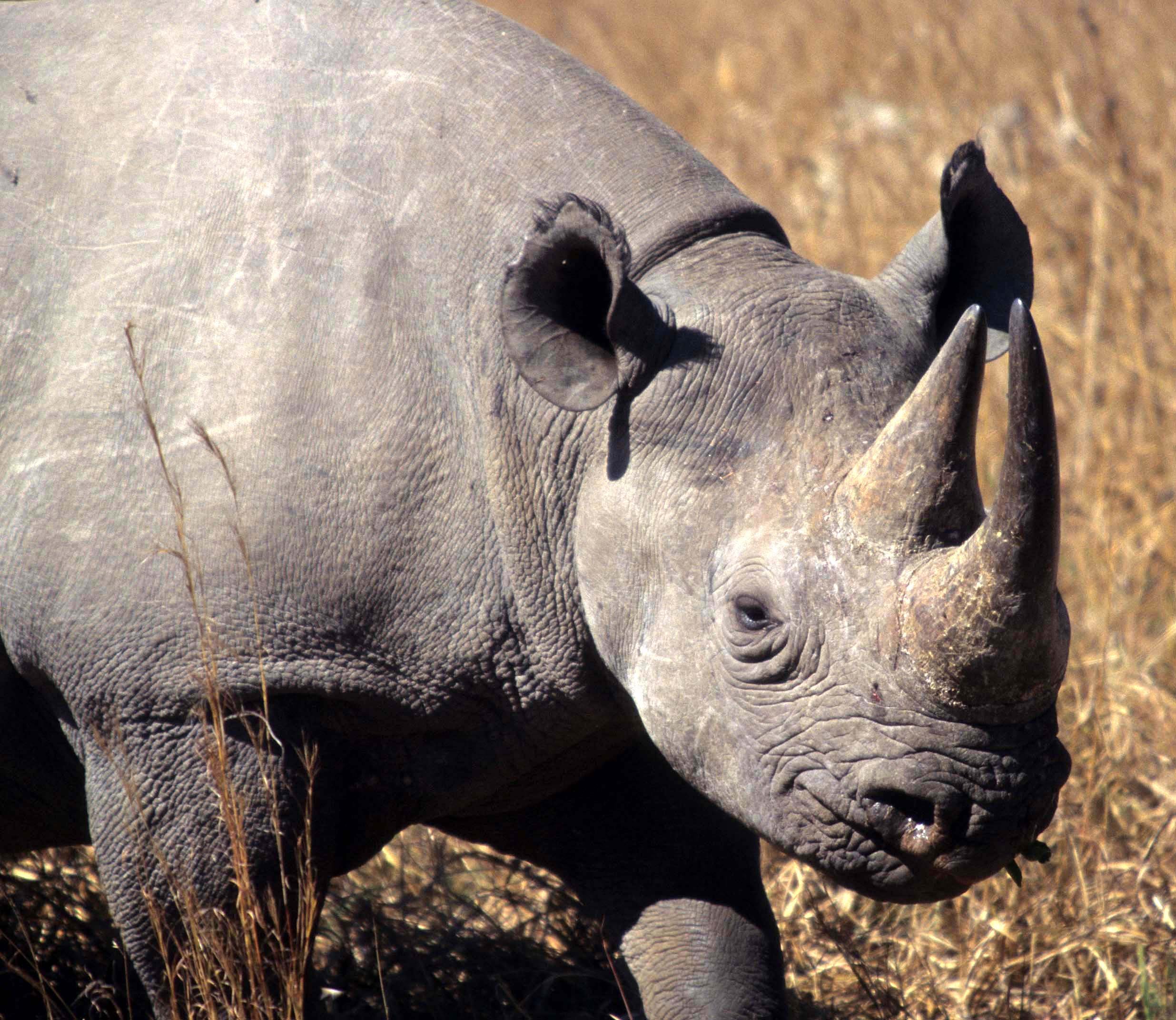

Southern Black Rhinoceros (Diceros bicornis bicornis)
The Southern Black Rhinoceros, southern hook-lipped rhinoceros or Cape rhinoceros (Diceros bicornis bicornis) is an extinct subspecies of the black rhinoceros that was once abundant in South Africa from the Cape Province to Transvaal, southern Namibia, and possibly also Lesotho and southern Botswana. It was brought to extinction by excessive hunting and habitat destruction around 1850.
It is unknown from where the original specimen (the holotype), on which Carl Linnaeus based "Rhinoceros" bicornis in 1758, was collected. It was even proposed that it was indeed the skull of an Indian rhino (Rhinoceros unicornis) with a faked second horn, as Linnaeus erroneously noted India as occurrence. This was fixed formally in 1911, when O. Thomas declared the Cape of Good Hope as type locality of D. bicornis. Therefore, this population formed the base of the nominal subspecies of the black rhinoceros. Later this subspecies became frequently mistaken for the south-western black rhinoceros, but the latter has to be considered a separate subspecies (D. bicornis occidentalis).
Southern Black Rhinoceros, southern hook-lipped rhinoceros or Cape rhinoceros (Diceros bicornis bicornis) in Etosha







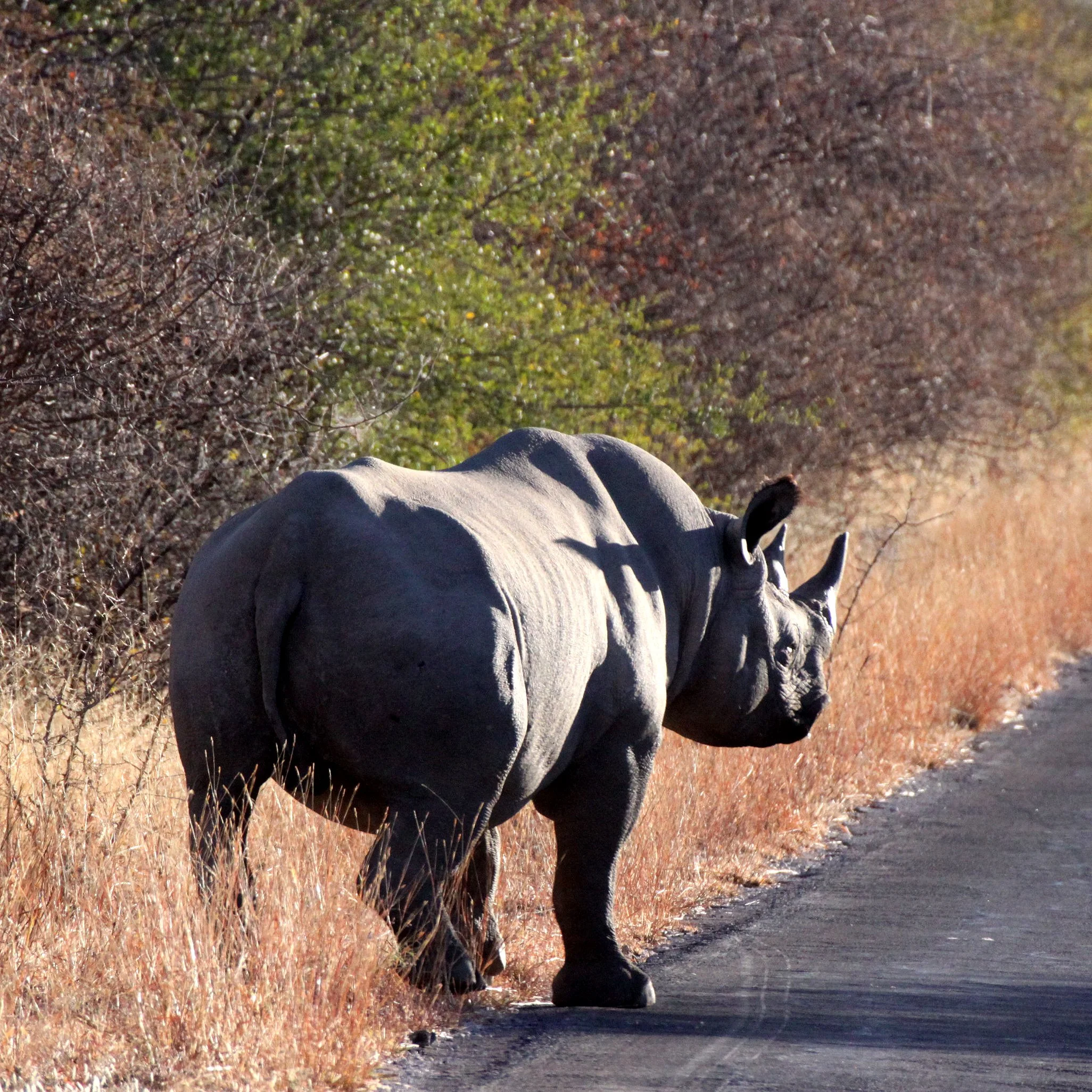
























































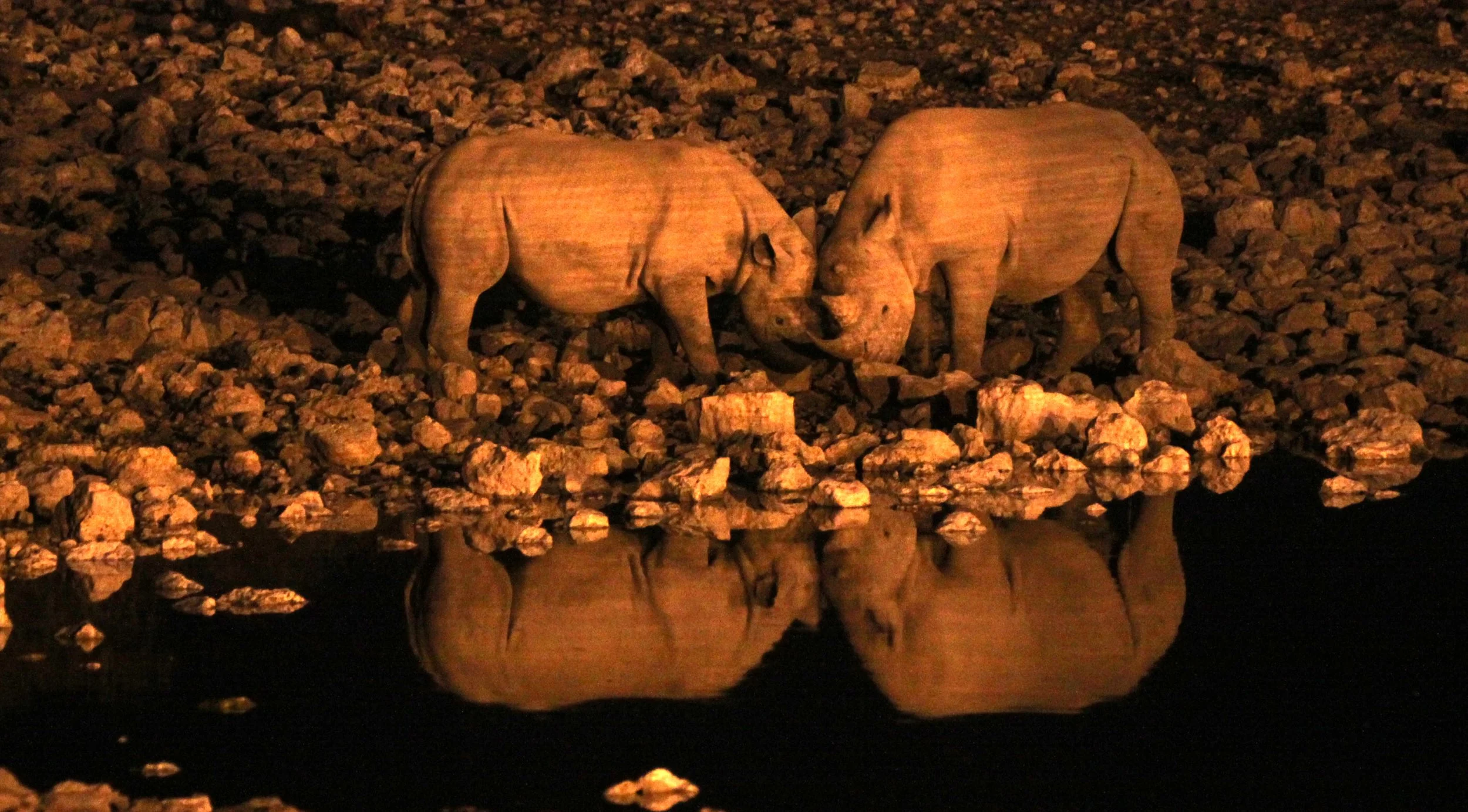








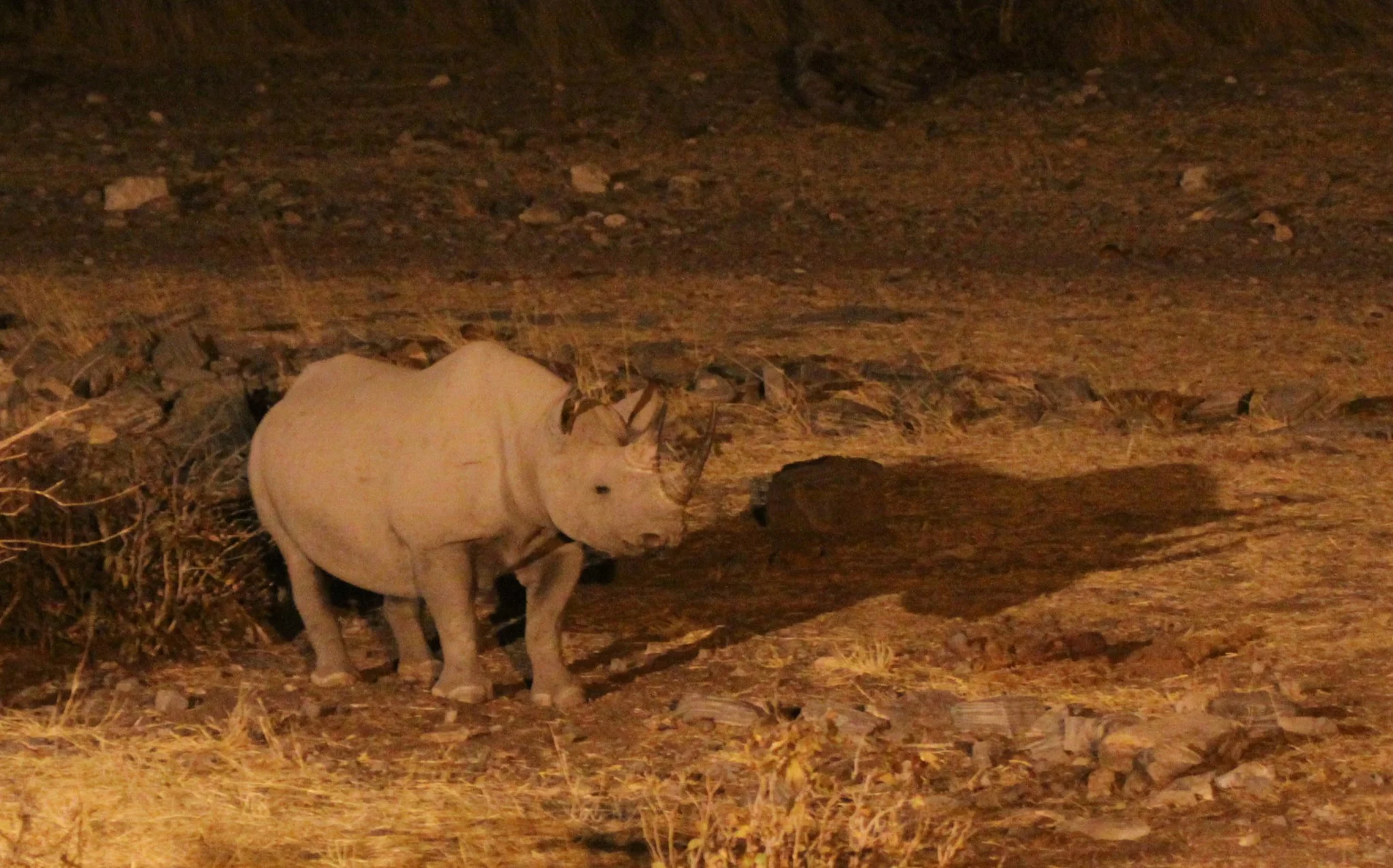




Indian Rhinoceros (Rhinoceros unicornis)
The Indian Rhinoceros (Rhinoceros unicornis), also called the Indian rhino, greater one-horned rhinoceros or great Indian rhinoceros, is a rhinoceros species native to the Indian subcontinent. It is listed as Vulnerable on the IUCN Red List, as populations are fragmented and restricted to less than 20,000 km2 (7,700 sq mi). Moreover, the extent and quality of the rhino's most important habitat, the alluvial Terai-Duar savanna and grasslands and riverine forest, is considered to be in decline due to human and livestock encroachment. As of August 2018, the global population was estimated to comprise 3,588 individuals, including 2,939 individuals in India and 649 in Nepal. Kaziranga National Park alone had an estimated population of 2,048 rhinos in 2009. Pobitora Wildlife Sanctuary in Assam has the highest density of Indian rhinos in the world with 84 individuals in an area of 38.80 km2 (14.98 sq mi) in 2009.
Indian rhinos once ranged throughout the entire stretch of the Indo-Gangetic Plain, but excessive hunting and agricultural development reduced its range drastically to 11 sites in northern India and southern Nepal. In the early 1990s, between 1,870 and 1,895 Indian rhinos were estimated to have been alive. Since then, numbers have increased due to conservation measures taken by the government. However, poaching remains a continuous threat, as more than 150 Indian rhinos were killed in Assam by poachers between 2000 and 2006.
Nearly 85% of the global Indian rhinoceros population is concentrated in Assam, where Kaziranga National Park contains 70% of rhino population.
Indian rhinos once ranged across the entire northern part of the Indian Subcontinent, along the Indus, Ganges and Brahmaputra River basins, from Pakistan to the Indian-Myanmar border, including Bangladesh and the southern parts of Nepal and Bhutan. They may have also occurred in Myanmar, southern China and Indochina. They inhabit the alluvial grasslands of the Terai and the Brahmaputra basin.[4] As a result of habitat destruction and climatic changes its range has gradually been reduced so that by the 19th century, it only survived in the Terai grasslands of southern Nepal, northern Uttar Pradesh, northern Bihar, northern West Bengal, and in the Brahmaputra Valley of Assam.
The species was present in northern Bihar and Oudh at least until 1770 as indicated in maps produced by Colonel Gentil. On the former abundance of the species, Thomas C. Jerdon wrote in 1867:
“This huge rhinoceros is found in the Terai at the foot of the Himalayas, from Bhutan to Nepal. It is more common in the eastern portion of the Terai than the west, and is most abundant in Assam and the Bhutan Dooars. I have heard from sportsmen of its occurrence as far west as Rohilcund, but it is certainly rare there now, and indeed along the greater part of the Nepal Terai; ... Jelpigoree, a small military station near the Teesta River, was a favourite locality whence to hunt the Rhinoceros and it was from that station Captain Fortescue ... got his skulls, which were ... the first that Mr. Blyth had seen of this species, ...”
Today, its range has further shrunk to a few pockets in southern Nepal, northern West Bengal, and the Brahmaputra Valley. Its habitat is surrounded by human-dominated landscapes, so that in many areas, it occurs in cultivated areas, pastures, and secondary forests. In the 1980s, Indian rhinos were frequently seen in the narrow plain area of Manas River and Royal Manas National Park in Bhutan.
In 2006, the total Indian rhinoceros population was estimated to comprise 2,577 individuals, of which 2,165 lived in India:
23 individuals in Uttar Pradesh, including 21 in Dudhwa National Park and 2 in Katarniaghat Wildlife Sanctuary
135 individuals in West Bengal, including 108 in Jaldapara National Park and 27 in Gorumara National Park
2,007 individuals in Assam, including 1,855 in Kaziranga National Park, 81 in Pobitora Wildlife Sanctuary, 68 in Orang National Park and 3 in Manas National Park.
Asian Rhino chasing me in Kaziranga, Assam
By 2014, the population in Assam increased to 2,544 Indian rhinos, an increase of 27% since 2006, although more than 150 individuals were killed by poachers during these years.[5] The population in Kaziranga National Park was estimated at 2,048 individuals in 2009. By 2009, the population in Pobitora Wildlife Sanctuary had increased to 84 individuals in an area of 38.80 km2 (14.98 sq mi).
In 2015, Nepal had 645 Indian rhinos living in Parsa National Park, Chitwan National Park, Bardia National Park, Shuklaphanta Wildlife Reserve and respective buffer zones in the Terai Arc Landscape as recorded in a survey conducted from 11 April to 2 May 2015. The survey showed that the population of rhinos in Nepal from 2011 to 2015 increased 21% or 111 individuals.
The Indian rhino population, which once numbered as low as 100 individuals in the early 1900s, has increased to more than 3,700 in year 2021 as per The International Rhino Foundation (IRF) signature 2021 report, State of the Rhino.
Bulls are usually solitary. Groups consist of cows with calves, or of up to six subadults. Such groups congregate at wallows and grazing areas. They are foremost active in early mornings, late afternoons and at night, but rest during hot days.
They bathe regularly. The folds in their skin trap water and hold it even when they exit wallows.
They are excellent swimmers and can run at speeds of up to 55 km/h (34 mph) for short periods. They have excellent senses of hearing and smell, but relatively poor eyesight Over 10 distinct vocalisations have been recorded. Males have home ranges of around 2 to 8 km2 (0.77 to 3.09 sq mi) that overlap each other. Dominant males tolerate other males passing through their territories except when they are in mating season, when dangerous fights break out. Indian rhinos have few natural enemies, except for tigers, which sometimes kill unguarded calves, but adult rhinos are less vulnerable due to their size. Mynahs and egrets both eat invertebrates from the rhino's skin and around its feet. Tabanus flies, a type of horse-fly, are known to bite rhinos. The rhinos are also vulnerable to diseases spread by parasites such as leeches, ticks, and nematodes. Anthrax and the blood-disease sepsis are known to occur. In March 2017, a group of four tigers consisting of an adult male, tigress and two cubs killed a 20-year-old male Indian rhinoceros in Dudhwa Tiger Reserve.
Indian rhinoceros (Rhinoceros unicornis) - images from Chitwan Nepal and Kaziranga Assam, India
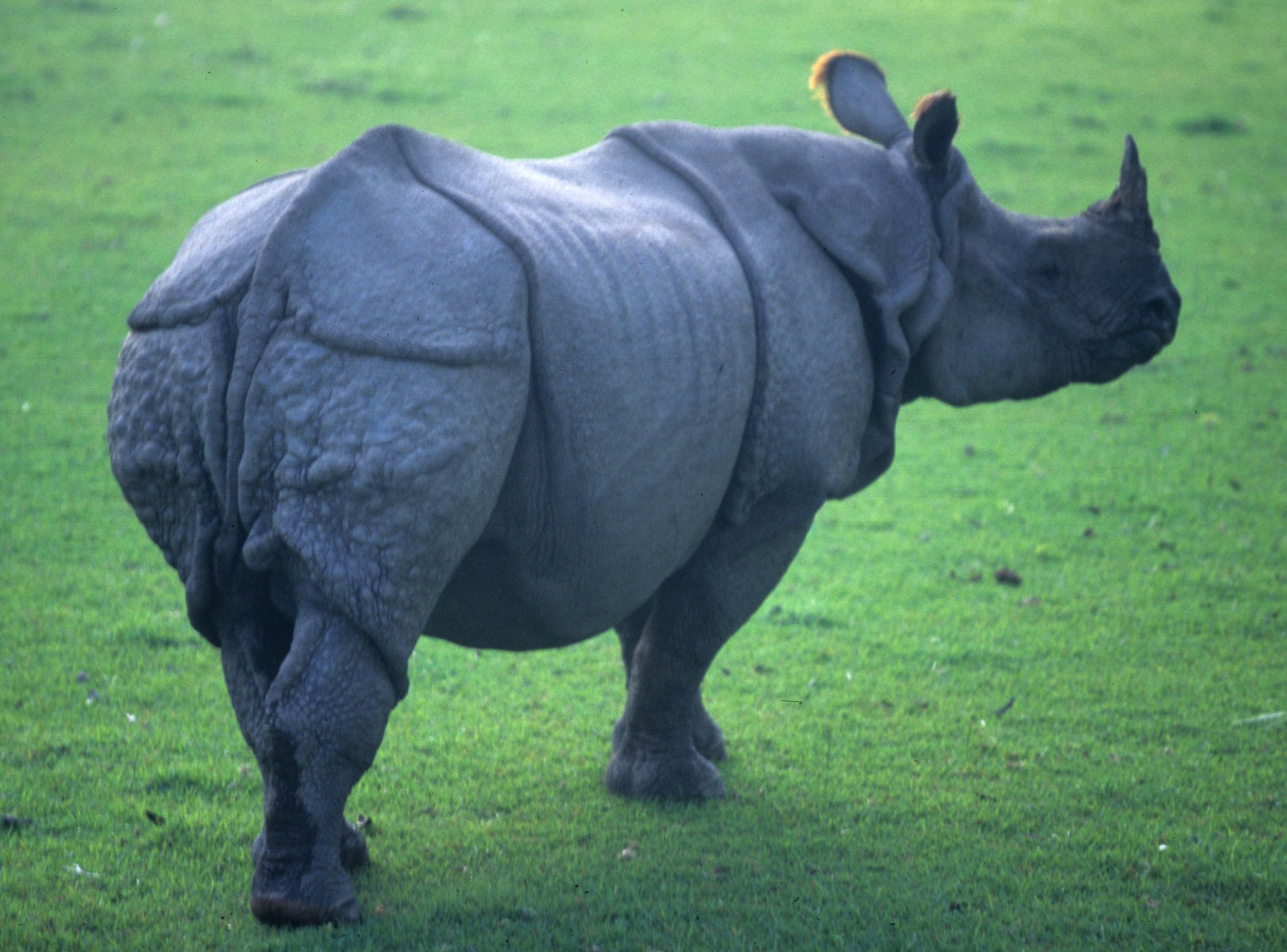
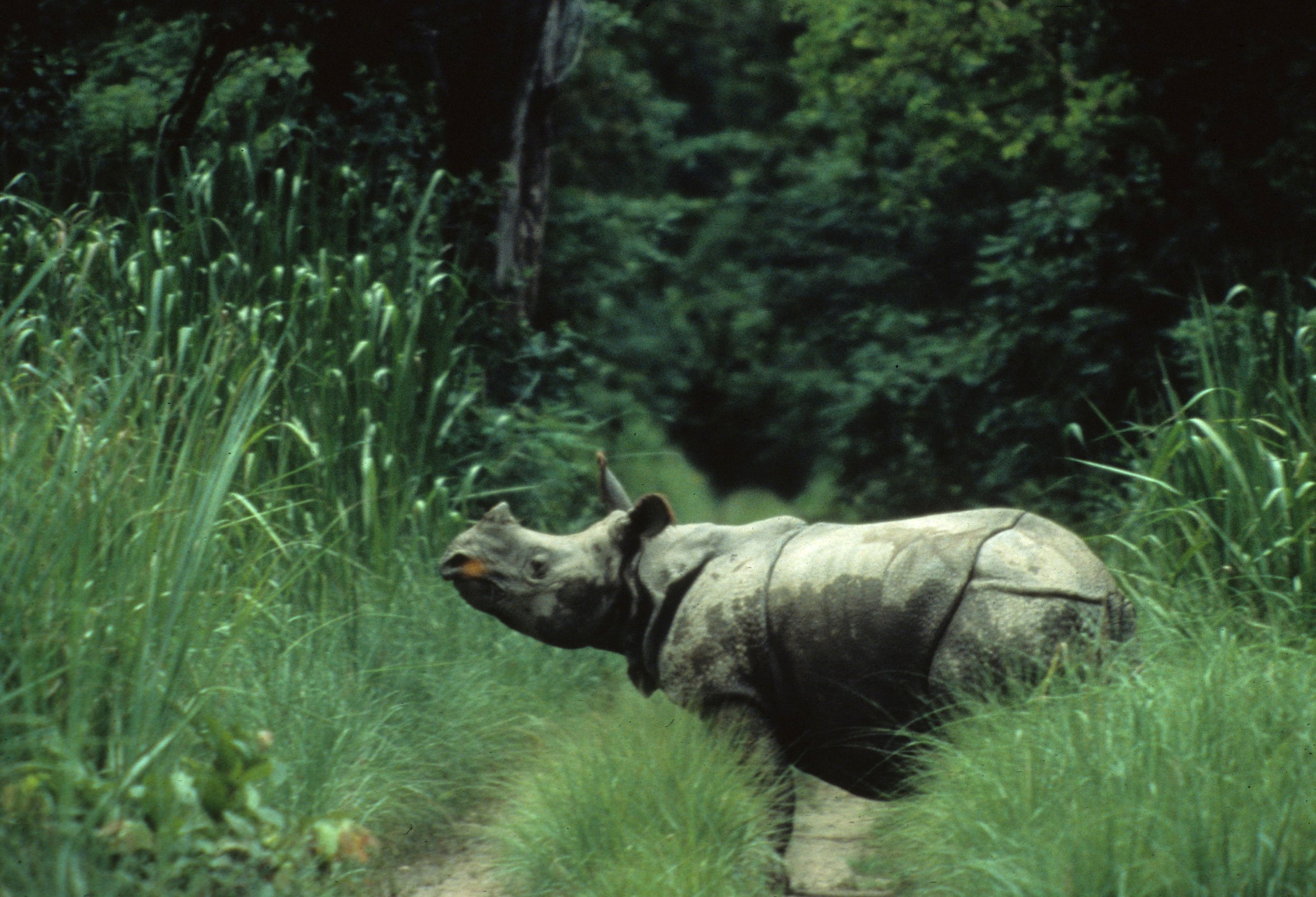
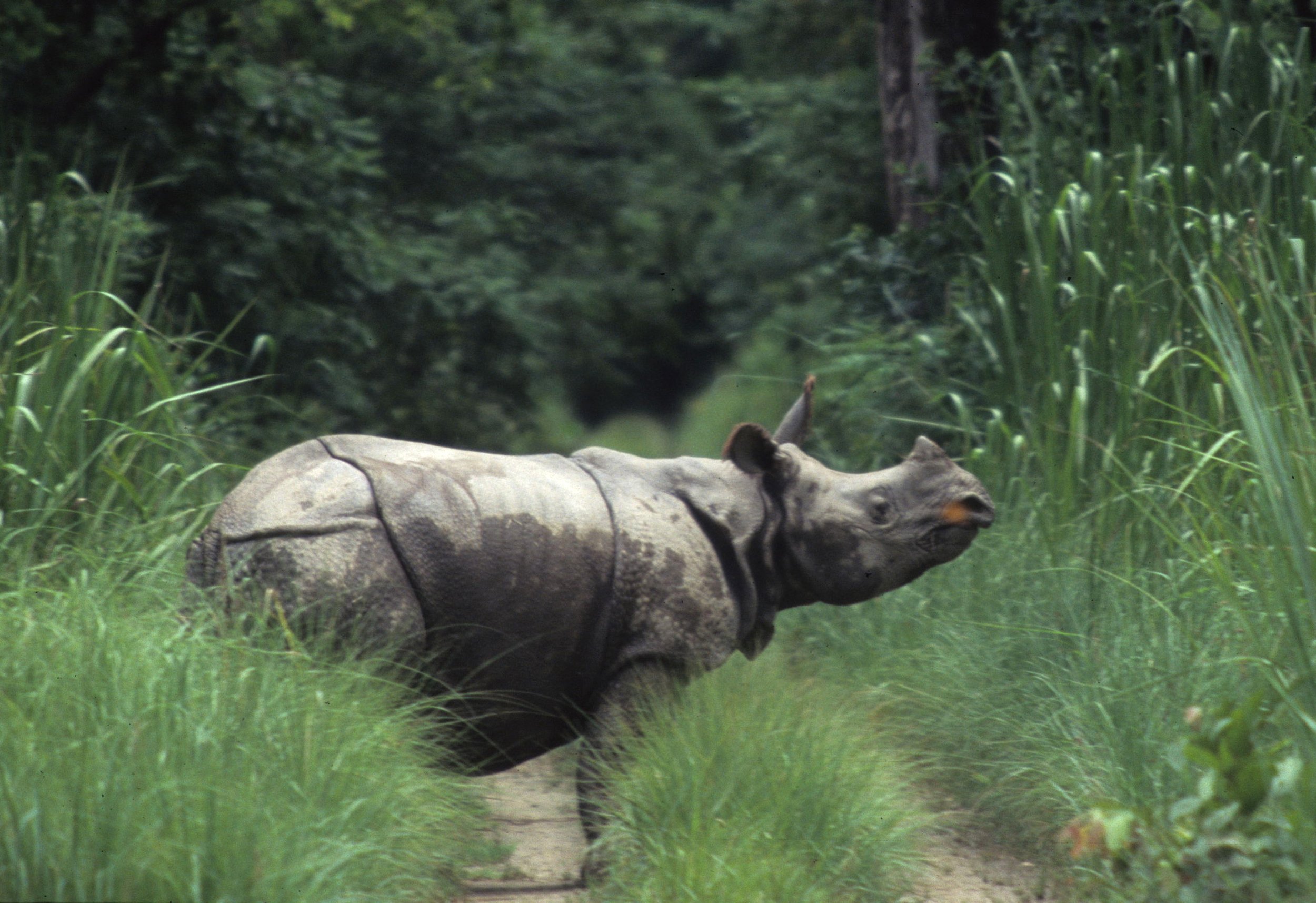
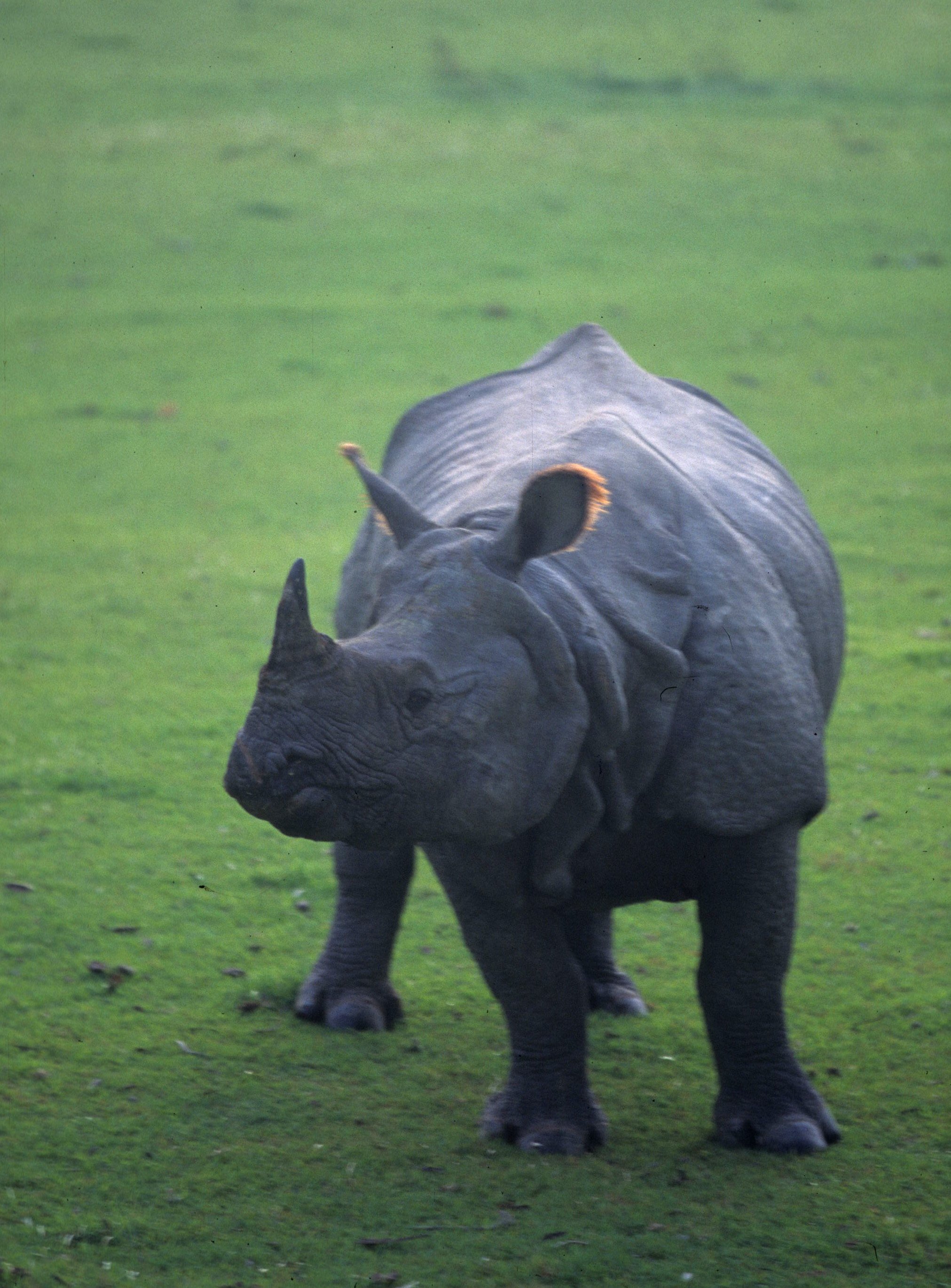
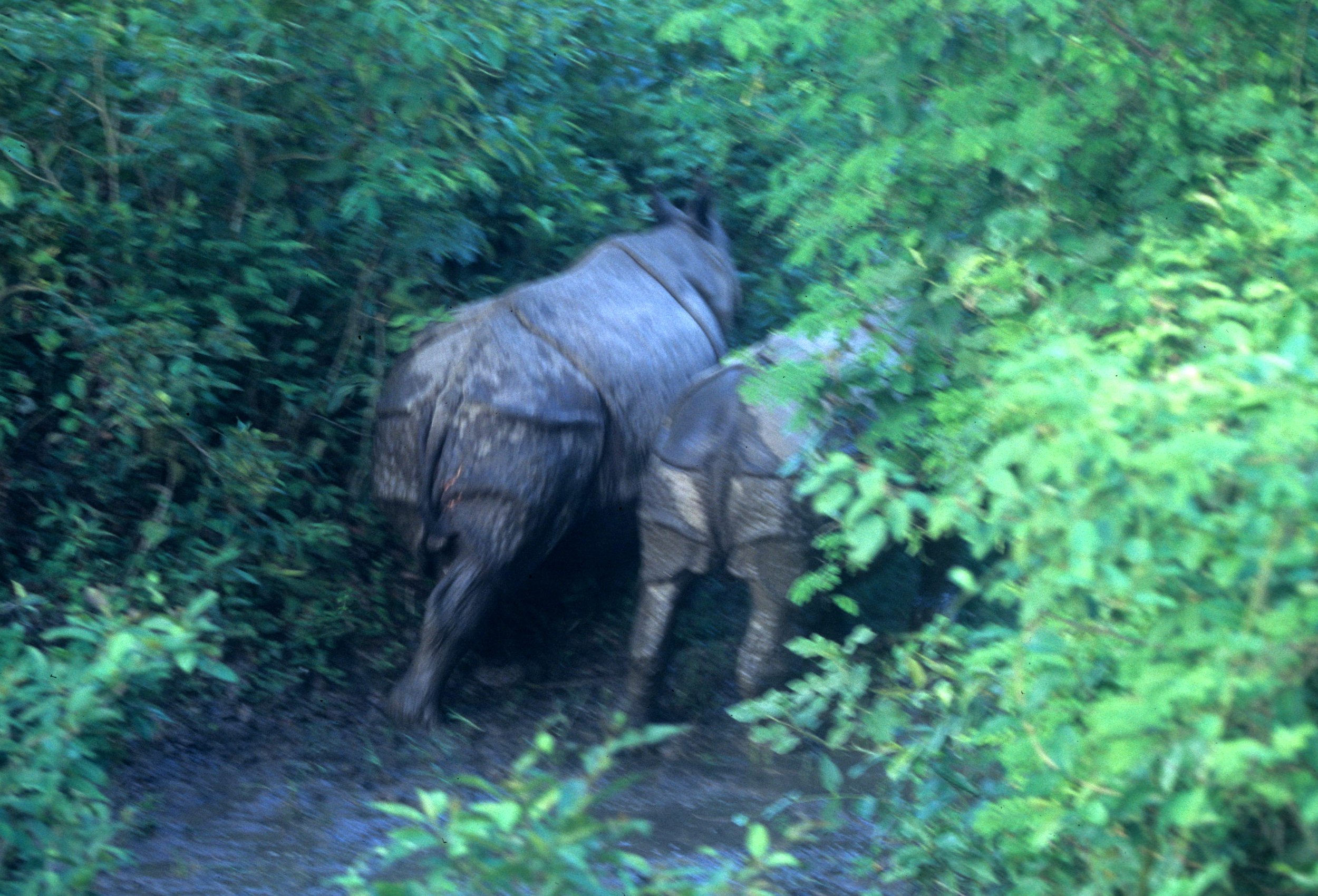
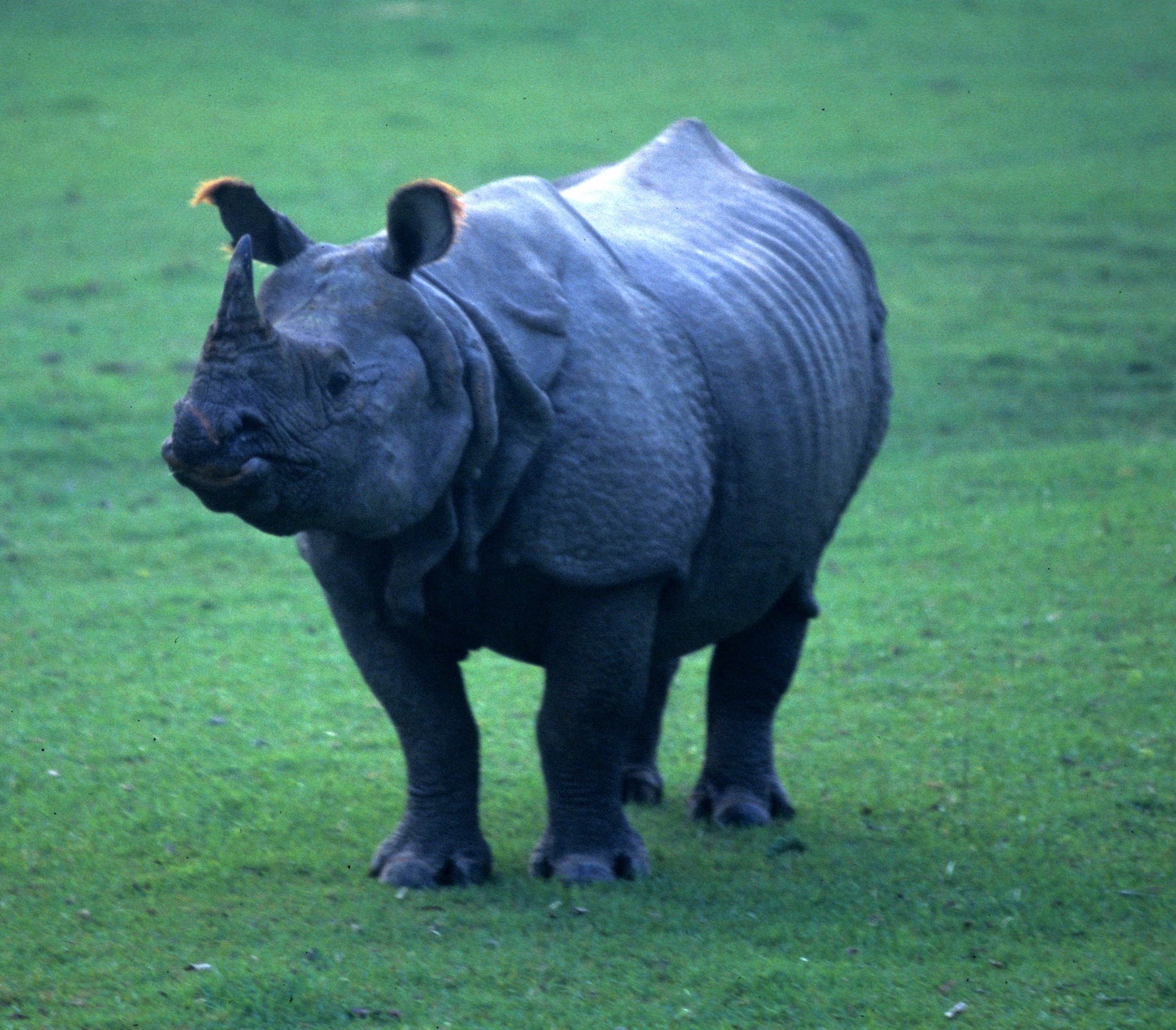



































































































































Javan Rhinoceros (Rhinoceros sondaicus)
The Javan Rhinoceros (Rhinoceros sondaicus), also known as the Javan rhino, Sunda rhinoceros or lesser one-horned rhinoceros, is a very rare member of the family Rhinocerotidae and one of five extant rhinoceroses. It belongs to the same genus as the Indian rhinoceros, and has similar mosaic, armour-like skin, but at 3.1–3.2 m (10–10 ft) in length and 1.4–1.7 m (4.6–5.6 ft) in height, it is smaller (closer in size to the black rhinoceros of the genus Diceros). Its horn is usually shorter than 25 cm (9.8 in), and is smaller than those of the other rhino species. Only adult bulls have horns; cows lack them altogether.
Once the most widespread of Asian rhinoceroses, Javan rhinos ranged from the islands of Java and Sumatra, throughout Southeast Asia, and into India and China. The species is critically endangered, with only one known population in the wild, and no individuals in captivity. It is possibly the rarest large mammal on Earth,[4]: 21 with a population of approximately 74 in Ujung Kulon National Park at the western tip of Java in Indonesia. The Javan rhinoceros population in Vietnam's Cat Tien National Park was declared to be locally extinct in 2011. The decline of Javan rhinos is attributed to poaching, primarily for their horns, which are highly valued in traditional Chinese medicine, fetching as much as US$30,000 per kg on the black market. As European presence in their range increased, trophy hunting also became a serious threat. Loss of habitat, especially as the result of wars, such as the Vietnam War, in Southeast Asia, has also contributed to the species' decline and hindered recovery. The remaining range is within one nationally protected area, but the rhinos are still at risk from poachers, disease, and loss of genetic diversity leading to inbreeding depression.
Javan rhinos can live around 30–45 years in the wild. They historically inhabited lowland rain forest, wet grasslands, and large floodplains. They are mostly solitary, except for courtship and offspring-rearing, though groups may occasionally congregate near wallows and salt licks. Aside from humans, adults have no predators in their range. Javan rhinos usually avoid humans. Scientists and conservationists rarely study the animals directly due to their extreme rarity and the danger of interfering with such an endangered species. Researchers rely on camera traps and fecal samples to gauge health and behavior. Consequently, Javan rhinos are the least studied of all rhino species. Two adult Javan rhinos with their calves were filmed in a motion-triggered video released on 28 February 2011 by WWF and Indonesia's National Park Authority, which proved it is still breeding in the wild. In April 2012, the National Parks Authority released video showing 35 individual Javan rhinos, including mother/offspring pairs and courting adults. There are only 58 to 68 individuals left in the wild, and none in captivity, after the death of a bull named Samson. Samson died in April 2018 at 30 years of age, far younger than the species' usual lifespan of 50 to 60 years, so DNA testing is being conducted to explore the cause of death, including the possibility of inbreeding degeneration.
Javan rhinoceros (Rhinoceros sondaicus) - images from Ujung Kulon Ranger Station. We saw one but too fast for images at “Rhino Central” deep inside the southern extreme of the park. Note the fresh pug marks in this gallery. The final image is not mine but is very similar to our sighting.








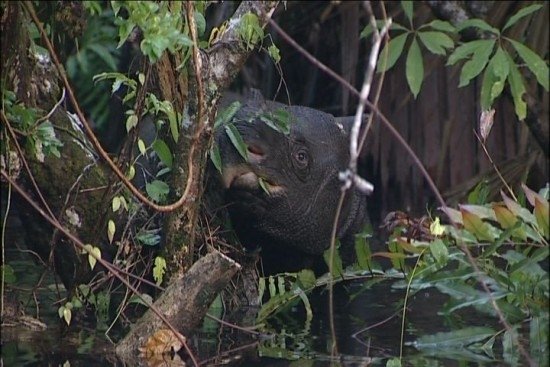
Sumatran Rhinoceros (Dicerorhinus sumatrensis)
The Sumatran Rhinoceros (Dicerorhinus sumatrensis), also known as the Sumatran rhino, hairy rhinoceros or Asian two-horned rhinoceros, is a rare member of the family Rhinocerotidae and one of five extant species of rhinoceros. It is the only extant species of the genus Dicerorhinus. It is the smallest rhinoceros, although it is still a large mammal; it stands 112–145 cm (44–57 in) high at the shoulder, with a head-and-body length of 2.36–3.18 m (7 ft 9 in – 10 ft 5 in) and a tail of 35–70 cm (14–28 in). The weight is reported to range from 500–1,000 kg (1,100–2,200 lb), averaging 700–800 kg (1,500–1,800 lb). Like both African species, it has two horns; the larger is the nasal horn, typically 15–25 cm (5.9–9.8 in), while the other horn is typically a stub. A coat of reddish-brown hair covers most of the Sumatran rhino's body.
The Sumatran rhinoceros once inhabited rainforests, swamps and cloud forests in India, Bhutan, Bangladesh, Myanmar, Laos, Thailand, Malaysia, Indonesia and southwestern China, particularly in Sichuan. It is now critically endangered, with only five substantial populations in the wild: four in Sumatra and one in Borneo, with an estimated total population of fewer than 80 mature individuals. The species was extirpated in Malaysia in 2019, and one of the Sumatran populations may already be extinct. In 2015, researchers announced that the Bornean rhinoceros had become extinct in the northern part of Borneo in Sabah, Malaysia.[8] A tiny population was discovered in East Kalimantan in early 2016.
The Sumatran rhino is a mostly solitary animal except for courtship and offspring-rearing. It is the most vocal rhino species and also communicates through marking soil with its feet, twisting saplings into patterns, and leaving excrement. The species is much better studied than the similarly reclusive Javan rhinoceros, in part because of a program that brought 40 Sumatran rhinos into captivity with the goal of preserving the species. There was little or no information about procedures that would assist in ex situ breeding. Though a number of rhinos died once at the various destinations and no offspring were produced for nearly 20 years, the rhinos were all doomed in their soon-to-be-logged forest. In March 2016, a Sumatran rhinoceros (of the Bornean rhinoceros subspecies) was spotted in Indonesian Borneo.
The Indonesian ministry of Environment, began an official counting of the Sumatran rhino in February 2019, planned to be completed in three years. Malaysia's last known bull and cow Sumatran rhinos died in May and November 2019, respectively. The species is now considered to be locally extinct in that country, and only survives in Indonesia. There are fewer than 80 left in existence.
While in Tabin, SOS Rhino had captured one and was in the pen in the image with the truck below. No images were allowed. Other images were in their visitors center.












